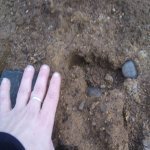Leaderboard
Popular Content
Showing content with the highest reputation on 03/03/2021 in all areas
-
My book about Port Chatham will be released this month. I'm having an online release party if any of you are interested. We will be giving away copies of the book and other fun stuff. Here is a link for the Facebook release party: https://fb.me/e/13zr5kVTq It will also be live on Youtube and hopefully, Instagram. March 20th 2021 at 3pm AKDT.1 point
-
^^ Thanks. Don't disagree w/your assessment. I simply know that I have far too little knowledge of, or experience with, moose, elks, bears of any color, etc. to judge.1 point
-
The other factor has been touched on but fully explored. Yes they are sentient. Yes they go to great lengths to avoid leaving footprints. I have seen that with every footprint I have found. And yes they have observed humans for thousands of years and pretty much can understand our behavior enough to avoid us. If you put a special forces or Navy Seal in at area and told him to avoid humans, They would know to avoid roads, not leave footprints, avoid human trails, walking a ridge skyline, traveling much in daylight hours, and killing a families livestock etc.. BF has learned all of that stuff too. I noticed some rock stacks in one area near some human trails. When I investigated I discovered a trail system that pretty much paralleled the human trails in the area. The rock stacks seemingly marked their trails especially where they crossed the human trail system. Also the rocks provided enough relief, that they could be seen in very dim light like moon or starlight. The trails were fairly well used, not as much as the human trails, but I did not find so much as a single deer or elk track on other trail system Something without hooves was using the trails. The human trails are very popular and BF simply use their own to avoid humans. Most road and trail sightings are crossing sightings,. I do not recall anyone seeing a BF walking down a human trail. I have on the other hand been nose to nose with a bear using my human trail.1 point
-
I agree with you. Most sightings go unreported. It might be discussed with family or friends, but people are either afraid of the stigma or just don't care to report their sighting to strangers. It's the same way with belief in these creatures in the mountains around here. It's just taken as a matter of fact that these creatures exist.1 point
-
There would have to be a level of intelligence involved... beyond the instincts of an undiscovered ape. The ability to recognize patterns of human behavior and to adapt/plan to actively work to stay hidden. Keeping their scat and most signs of their feeding hidden, planning their travel routes to mostly avoid human detection...and it all has to be species wide. One individual going off the reservation and trying to cross an interstate and getting hit or getting hungry and trying to take a cow in broad daylight...and they are discovered. It doesn't sound like an ape...it sounds like the traditional definition of a hominid...man or one of his ancestors. It sounds like the ability to pass along history and information in order to maintain a species-wide effort to conceal themselves.1 point
-
That's where we disagree. A sapient species seeking to avoid conflict with humans absolutely would pass up a cow or sheep except in times of great desperation. We ran 40-60 head on national forest year around. Since we never knew exactly how many we had we would have never noticed one missing unless we found the carcass. Right, but bigfoot is not bears or gorillas. Regarding humans, that is true today. I'm doing some reading. That doesn't appear to be true for hunter-gatherer humans, pre-agriculture, which would seem to be the correct case for comparison with bigfoot. .. but you are right, or at least seem to be, in one thing .. something IS off. Lot of things don't add up to match our assumptions. There may be one correction to all of those assumptions which could account for all aspects of that difference: what if there are a lot fewer than we think but we see them more often because they're not as constantly sneaky as we imagine? What if the total population is smaller but they travel farther, faster, and are exposed more often than we imagine? MIB1 point
-
1 point
-
There was some speculation that Neanderthals may have hibernated, but that theory never really went anywhere. I agree with you though... something is off with this phenomenon.1 point
-
But Bears like Gorillas have elongated intestinal tracts. And Bears don’t come close to hitting a 50% annual diet of meat. Many Humans do not hit that mark either. Leaving out cultural meat eaters like say the Inuit. Most meat is consumed by richer nations. While many third world countries get very little in their diet. No disrespect, but roving families of 800 lbs hunters eating half their diet in meat? I don’t think that’s going to go unnoticed in the woods. And as Magnaesir has pointed out? You would be having lots of conflicts with ranchers. Because something with that much appetite for flesh isn’t going to pass up a juicy cow or sheep. It wouldn’t be like dealing with something like a Bear at all. It would be more like dealing with a Cougar or Wolf. And most importantly? Primates do not hibernate. So this thing is out actively hunting in winter. So we should be cutting Bigfoot tracks as often as Cougar tracks. But we don’t see that. They are rare by comparison. I don’t pretend to have all of the answers, but something is off.1 point
-
There's a difference between the violence inherent to normal predation and the cruelty that some meat eating primates like chimpanzees display. Murder comes naturally to chimpanzees1 point
-
I would respectfully disagree with Dr Krantz on this one. Critters with the hindgut fermenter do not have ripped abs, rather, they have a "pus gut" like a gorilla, like the suit from Letters to the Big Man depicts ... inaccurately. Patty, though bulky does not have the distribution of bulk appropriate to that gut structure. The two I saw .. the littler one was built like a tight end, the bigger one like a beast of a fullback, neither like a sumo wrestler. I'm going to say, with as much confidence as you can have short of dissecting one, that Dr Krantz was mistaken. I'm going to say omnivore. Everything suggests whatever bears eat, bigfoots eat, and vice versa. To beat a dead horse further, omnivores like bears do not have that hindgut fermenter. What they eat is what is available .. and lots of it. Since the areas where I've seen bigfoots (not many, don't read too much into that) were not torn to shreds as they'd have been had a strict herbivore like gorillas had lived there, I believe the meat component of the diet may be well over 50%. MIB1 point
-
I truly don't know, but i find it strange for sure. I ended up doing that as i was talking to Shane Corson a few weeks back about some recent rock throwing reports out in WA (western of course) and just thought i'd take a look in to what if any, was the public info on other non human primates and found that West African study. What got my interest was the fact that they were showing and pushing the 'cultural behavior' line as i felt it would always be possible to find that within our subject, hence the focus on Washington and that was that. But i didn't stop there....;) In other areas of the PNW and the west coast, there's other 'strange' pockets of both pretty high density 'objects thrown' reports and areas of next to none at all which could possibly suggest that there are learned cultural behaviors within our subject and 'objects thrown' may just be one of them. For example, within the same mountain range as the above numbers but just further south and across state lines, the Oregon Cascades see's way different numbers to what the Washington Cascades see, a mountain range that has a natural divide of a (Columbia) river. Washington Cascades (240 miles in length approx) - 1/14 reports consist of 'objects thrown' out of 419 reports total (7%). Oregon Cascades (360 miles in length approx) - 1/178 reports consist of 'objects thrown' out of 178 reports total (0.05%). That's a big difference. Other notable numbers. Oregon Coastal Range - 1/25 reports consist of 'objects thrown' out of 100 reports total. Eastern Oregon - 1/25 reports consist of 'objects thrown' out of 49 reports total. Pattyville (Klamath Mountains OR and CA) - 1/106 reports consist of 'objects thrown' out of 211 reports total. Sierra Nevada Mountains CA - 1/20 reports consist of 'objects thrown' out of 196 reports total. It's all food for thought if nothing else BUT, at least we have a starting foundation and confirmation of learned cultural behavior in non human primates with that West African study of Chimps, it's something to at least give me the emphasis to spend further time on this kind of stuff.1 point
-
I think Standing is a hoaxer is why. While Justin is a honest man. That’s why you see the discrepancy in evidence. I would rather watch an honest man in the woods, than “exciting” dramatized hooey. After the muppet heads? Standing cannot be trusted in my book.1 point
This leaderboard is set to New York/GMT-05:00








